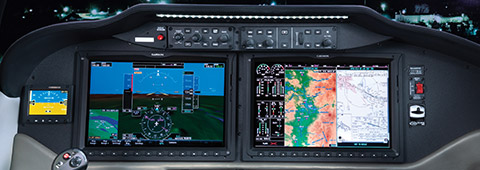
Even with Garmin’s odd naming conventions, it seemed predictable that the company that brought us the G1000 (in 2004) and the G3000 (in 2009) was likely working on something in between.
The famously secretive firm is now unveiling the G2000—a two-box PFD/MFD combination with a touch-screen flight management system (FMS) aimed at new, high-end, piston aircraft. The G2000 has a far less complex user interface, and fewer knobs and soft keys than the G1000. It also brings the best attributes of the three-screen G3000 made for turbine aircraft to the piston market.
Garmin announced the G2000 and its launch customer, the Cessna Corvalis, at the Sun ’n Fun Fly-In at Lakeland, Fla. AOPA Pilot got an early look at the G2000 during a visit to Garmin headquarters in Olathe, Kan., and it was immediately apparent that Garmin’s move to touch screens, which started with the aera portables, moved to panel-mount GPS/Comms with the GTN 600/700 series, and corporate jets with the G3000 and G5000, continues in the G2000.
The 5.7-inch (diagonal) FMS keypad presents a colorful and comprehensive group of icons—and it’s meant to be touched. (Pilots will have to be reminded to keep their grubby mitts off the big 12- or 14-inch PFD and MFD screens.)
“The beauty of the touch screen is that you touch what you want to change,” said Bill Stone, a Garmin engineer. “There is no memorization, and there aren’t multiple steps to go through to make the G2000 do what you want it to do.”
Although the G2000 is a two-screen system, the MFD has a handy split-screen feature that allows pilots to display a moving map and a full-sized approach plate at the same time, a trick that makes the G2000 behave more like a three-screen system.
Unlike the G1000 with its scores of button and soft-key combinations, the G2000 is far more streamlined. All autopilot functions are on a single command bar atop the instrument panel. And the MFD has no soft keys whatsoever in normal operations.
The touch-screen FMS uses an infrared matrix that allows pilots to wear gloves, or not, without affecting performance. (The portable aera, by contrast, requires physical pressure on the screen, and the GTN series makes an electrical connection between the screen and the user’s finger.)
Garmin has sold tens of millions of touch-screen automotive and marine GPS units, but the infrared matrix technology had previously only been offered on the G3000 for FAA Part 23 aircraft and G5000 for Part 25 airplanes. (Whether the company someday offers a G4000 is anyone’s guess.)
The only buttons and knobs on the G2000 FMS are a radio volume/squelch adjustment, a dual concentric knob for data entry, and a joystick for on-screen panning. That’s it.
The G2000 can be driven by one or two attitude heading reference system (AHRS) computers, and Garmin officials say they expect most customers to go with the redundancy of dual-AHRS installations. Garmin also offers its Electronic Stability and Protection (ESP) system, which helps pilots avoid unintentional stalls, spirals, and departures from controlled flight, as a G2000 option, as well as Garmin synthetic vision technology.
The G2000 isn’t being offered as a retrofit for G1000-equipped airplanes, and Garmin isn’t saying whether it will sell an Experimental version similar to the G900X, a non-TSO version of the G1000. The company also isn’t naming a price as G2000s (like G1000s before them) only are sold to new aircraft manufacturers.
The G2000 also highlights an ongoing tension between Garmin—which would like to standardize its avionics offerings—and aircraft manufacturers who like putting their own stamps on them (i.e., Cirrus “Perspective” and Embraer “Prodigy” are both customized versions of the G1000). Most aircraft manufacturers make their imprint by coming up with their own style of FMS interface, but that won’t be easy on the G2000’s touch-screen keypad (although the software and icons can be easily modified).
Garmin brought in hundreds of pilots with widely varying experience levels and backgrounds to evaluate the G2000 and its touch-screen FMS during development. Most found the system easy to learn.
“It’s more intuitive and more efficient than any comparable system,” Stone said. “That was true for new pilots right out of flight training, as well as high-time corporate and airline pilots with no previous Garmin experience.”
Might Garmin someday do away with the FMS and go to an entirely touch-screen system with its big integrated avionics suites?
Company officials aren’t ruling it out. But the biggest obstacle isn’t technology or cost. It’s simply finding a way for pilots to reliably touch the part of the screen they’re aiming for on a big piece of real estate like a 12- or 14-inch PFD or MFD screen.
“Maybe someday,” Stone said. “But we won’t do it until we can find a way for pilots to accurately touch targets in the middle of the screen when their airplanes are flying in turbulence. Right now, that’s just not possible.”



